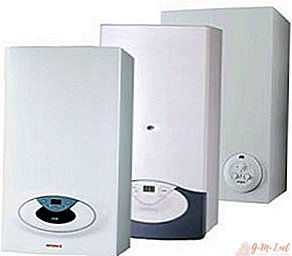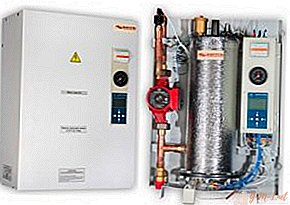 Creating a warm comfortable atmosphere of a private house in the winter, depends on a properly selected and correctly installed heat source. If there is no gas supply and the consumer does not want to get involved in the preparation of solid or bulk fuel, the use of electrical equipment for heating homes will be a simple and correct solution.
Creating a warm comfortable atmosphere of a private house in the winter, depends on a properly selected and correctly installed heat source. If there is no gas supply and the consumer does not want to get involved in the preparation of solid or bulk fuel, the use of electrical equipment for heating homes will be a simple and correct solution.
Advantages and disadvantages of electric boilers
The electrical equipment used to heat the coolant of autonomous heating systems has several advantages.
- Unlike gas and solid fuel units, electric ones are not used during the operating mode of heating an open flame source. The design of the electrical equipment provides for the heating of the coolant through the influence of physical processes by special elements of the boiler, caused by exposure to electric current.

- The absence of burners and flame allows electric boilers to be fireproof, with proper wiring. For the same reason, there are no harmful emissions into the atmosphere, in contrast to the "counterparts" using fossil resources.
- When summing up the gas main used for heating, it is necessary to observe a whole list of technical conditions that will be presented by gas workers serving the territory of the household. At the same time, the low price of gas for years to come will be reflected several times in the cost of design documentation and pipe laying. And the availability of electricity does not require any coordination.
- For solid fuel, and sometimes gas boilers, a special boiler room is required, equipped with all the necessary attributes of fire and technological equipment. The compactness of electrical units allows you to fit heating appliances into the interior of any living room.
- The design of electrical equipment is quite simple to manage and operate. The operating mode of heating the coolant does not require control. Using simple power buttons, set the desired parameters. Further consumer participation in the operation of the boiler occurs when necessary to adjust the set parameters.
- The low price and lack of need for storage facilities for solid or liquid fuel is also an advantage of electric boilers.
The installation of electrical equipment has disadvantages:
- The high cost of electricity and the lack of technical ability to heat cottages of large sizes.
- The use of electric boilers is effective in closed circuits of heating systems, and this will entail the alteration and appreciation of existing internal house highways. The operation of electrical equipment during natural circulation or an open expansion tank leads to a decrease in thermal power, and therefore - the relevance of the application.
In addition, the installation of an electrical unit is often associated with the installation of additional elements:
- circulation pump to create a closed circuit;
- voltage stabilizer with high sensitivity to extremes;
- replacement of the heat carrier with a chemically neutral one, with a specific resistivity, for electrode boilers;
- replacement of radiators, because hydrogen sulfide can form in the water, which destroys aluminum.
IMPORTANT! With a house area of more than 150 square meters. m will require a significant increase in consumed electrical energy, and this may entail the laying of a separate electric highway, with all the ensuing bureaucratic difficulties!
What to look for when choosing an electric boiler for a private house
When choosing electrical equipment for heating the coolant of the heating system of their own home, first of all, they use the power criterion, and then pay attention to the equipment of the unit, which will cope with the resistance of pipes and radiators in the required rooms.
Power
 The individual features of the construction of private households oblige, when calculating, to get away from the standard calculation of the consumed heat power, which reduces to the value of 100 W / sq. m. The given value is relevant for multi-apartment buildings, with a ceiling height of up to 2.65 m.
The individual features of the construction of private households oblige, when calculating, to get away from the standard calculation of the consumed heat power, which reduces to the value of 100 W / sq. m. The given value is relevant for multi-apartment buildings, with a ceiling height of up to 2.65 m.
SNiPs provide a large number of factors affecting the correctness of the calculated power value. Building codes recommend using in the middle latitudes 41 W / cu. m, for calculating a heated room. To adjust the calculated value, correction factors are used. To understand how to calculate the thermal power required for heating a private home, consider an example of calculation.
Two-storey cottage, the ground floor area of 100 square meters. m, the second - 60 square meters. m, the ceiling height is 3 m. On one of the walls of the top floor there are energy-saving double-glazed windows, all window openings are oversized, relative to the standard, the roof and walls of the house have a foam insulation of 100 mm thickness.
A calculation using the usual recommendation of volume standards will look like:
(100 + 60) x3x41 = 19680 watts.
Given the influence factors:
- detached building - + 20%;
- the wall of the second floor is glazed - + 1%;
- increase in the size of window openings - + 10%;
- cottage insulation - -15%.
As a result, 20 + 1 + 10-15 = 16%.
The interest received must be added to the calculated value, in the end - 19680 + 16% = 22828.8 watts.
ATTENTION! For the southern regions, a correction factor of 0.9 is used, and for northern latitudes located above 60 degrees. - 1.2!
The calculation will help the owner of the house to correctly determine the required heat output of the heating equipment.
Dimensions, the number of circuits, the presence of automation
 Modern electric boilers for heating are equipped with automatic control of the heating medium heating mode. Depending on the user's requirements, the sensors controlling the unit on and off react to both the water parameters in the system and the room temperature.
Modern electric boilers for heating are equipped with automatic control of the heating medium heating mode. Depending on the user's requirements, the sensors controlling the unit on and off react to both the water parameters in the system and the room temperature.
Most heating appliances have one circuit, because for heating several, a large amount of electric energy is required. The presence in the heating system of several circuits, for example, the floor distribution of the coolant or separation of individual rooms in different modes, requires the installation of additional equipment on pipelines and taps.
Electric boilers are not always equipped with a circulation pump and a membrane tank. Their absence will require additional costs for the acquisition and installation. The characteristics of the pump and tank must comply with the requirements for installation:
- an electric pump, regardless of the manufacturer, has a digital designation of operation and connection parameters, for example, 25/4 or 30/8; the first digit indicates the diameter of the connection, and the second - the height that it overcomes;
- the capacity of the membrane tank should be at least 6-10% of the volume of the coolant.
The mismatch of the boiler equipment to the technical parameters of the heating system will not allow maintaining the desired temperature in all rooms of the building and will require replacing the pump or tank.
REFERENCE! For ease of maintenance, many manufacturers install a pipe for draining water from the unit, and some do not!
Types of electric heating boilers
Depending on the design of the heating element, electrical units are:
- Heating elements, in which heating is performed by tubular elements located inside a water tank. By means of a circulation pump, the fluid constantly moves through the pipelines, then returns to the heater again. The manufacturing technology of electric boilers provides for the presence of two or more heating elements that are turned on, depending on the requirements of the temperature regime.

- Induction units use, based on the heating principle, a coil with a ferromagnetic core, which, similar to the operation of a transformer, after supplying current to the winding, is heated and transfers heat to steel pipes with a coolant. Unlike heating elements, the heating element is protected from scale, has a large surface for heat transfer. Such equipment is more efficient and reliable, which is reflected in the high cost.
- Electrode boilers are simple in design. Current is supplied to the housing and the electrode located inside, at a small distance from the inner surface. Due to the potential difference between the parts of the unit and the specific resistance of the water, the coolant heats up, and then moves through the pipelines of the heating system.
ATTENTION! The use of heating elements of a tubular type in flow systems leads to the formation of scale and a decrease in thermal power!
Such equipment is in the form of a compact pipe with a small extension for connecting electricians. Needs a circulation pump and a tank of membrane type. Automation of heater control is performed as a separate unit. The low cost of electric boilers is compensated by high requirements for the quality of the coolant: it must have a resistivity regulated by the chemical composition. Due to the direct transfer of heat from electricity to water, this product segment has a high efficiency. Such heating devices are classified as energy efficient.
REFERENCE! A coolant leak will not harm this equipment! Without water, the unit will stop heating up, and energized surfaces located at a safe distance will remain in a closed internal cavity!
Having understood the design differences of electric boilers, as well as the features of selection and configuration, the consumer will understand which heat source to choose for their own home.



Leave Your Comment